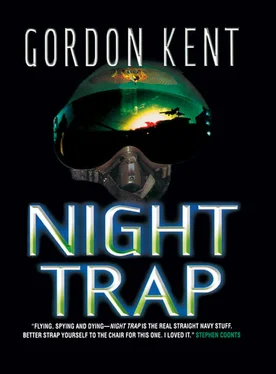Their first liberty ports behind them, the Roosevelt and the Jefferson moved down the Med in seemingly separate paths. The two great ships transited the Suez three weeks apart, then lingered briefly within a hundred miles of each other at the mouth of the Red Sea. Roosevelt docked at Mombasa; Jefferson forged eastward toward the Gulf, where Iran and Iraq, exhausted from their war, still lay spitting and snarling at each other like wounded cats. For Alan Craik, the carrier became his life. A meeting with Kim in Bahrain was dreamlike, quickly relegated to a vague background of fantasies and remembrance, against which his real world played. Real life was intelligence and flight, the CVIC and Christine. Now, he was like a hungry man let loose at a banquet table: he devoured and devoured and wanted more.
Over those three months, the two carriers approached each other and moved away, partners in a vast dance discernible only to their captains—never close enough to make a common nuclear target, never far enough apart to foreclose joint operations. Four months after they had passed Gibraltar, they reached designated points within range of the Iranian coast and began to brief their aircrews on the mission labeled KNIGHTHOOD.
On the scale of air warfare, the carrier is a siege engine; its target is a vast fortress of electronics and missiles. Night is the preferred environment, when men’s eyes fail and the side with the best electronic vision wins.
On the night sea, the deck of the carrier is a vision from some ancient legend, lit by flashes like lightning, tense with the nervous movements of men, raucous with sounds like the forges of Vulcan. The senses are battered by the power of the thing, the urgency and vigor of its component parts. Planes land in a roar and flash of sparks or leap into the air from hidden catapults. All around, men labor in shifting, flickering light, while the deck vibrates with the power of the screws and the planes and the machinery, and you feel the vibration in your very bones. The smell of JP-5, the lifeblood of naval aviation, is everywhere.
Beneath this sensual assault is intellectual wonder that the engine works. Men scurry through the noise, the patches of light and blackness, the danger; mysterious instructions whisper down dozens of radio channels; planes are fueled, repaired, launched, recovered, given ordnance, checked for weight, preflighted, tied down, chocked, released, rolled, towed; alerts are set and manned; while high overhead those aloft conduct their missions, talk to the tower, talk to each other, refuel in the air, prepare to land, parts of the great engine even while distant from it. Below the flight deck, intelligence plans missions, reviews debriefings, plays off future against past; powerful computers trade immense quantities of information about the carrier, her friends, her enemies, and all the complex world that now falls between. Elsewhere within, her crew is fed, their clothes are washed, their spaces are kept clean and neat, their beds are made, their confessions are heard and their prayers are spoken, their frailties are punished and their successes are rewarded, all while the ship drives through the water, powered by her nuclear heart. Almost six thousand humans crew her and her brood of aircraft, and very few of them are sleeping now.
All of this marvel is directed toward a single goal: the extension of naval supremacy through the air to any target. Opposed to it this night is the modern technological fortress, the integrated air defense system—the IADS, sterile name for a citadel that might once have been called Ticonderoga or the Krak des Chevaliers. Lay out this IADS on the map and you will see a many-layered fortress: the early-warning radars as the outer wall, spaced in rough terrain, bunched in smooth, surrounding clumps of smaller forts—missile sites—that defend potential targets; yet more sites defend the sector headquarters; at the center of all sits the air defense command, controlling all, ready to call up fighter aircraft the way Saladin once called up his cavalry.
The early-warning radars are the eyes of the system. They are everywhere—perimeter, SAM sites, defense areas, every attack corridor. The SAMs—surface-to-air missiles—are the archers; at each SAM center is a powerful, long-range missile site that must in its turn be protected by smaller SAMs and conventional anti-aircraft (AAA). The AAA remains deadly against low-flying attackers; it is not tricked by chaff and flares—the electronic dust thrown into radar’s eye. Each SAM site also has fire-control radars, a field of microwave dishes, land lines, cables, and communications devices: it is no small thing.
Communication is essential, because the radar horizon on our small planet is a measly twenty-two miles. Even from a mountain or a giant tower, a radar sees only thirty or forty miles—in the age of supersonic aircraft and big-stick (long-range) missiles, like being legally blind. Therefore, it is only at a headquarters controlling hundreds of EW radars that an incoming attack can be understood and that understanding passed to the SAM sites, usually by regions or sectors. At the center of all the sectors is the Air Defense Headquarters, resolving conflicts between sectors and controlling the fighter force.
This, then, is the siege warfare of the late twentieth century, when the besieger moves at hundreds of miles an hour, attempting to destroy EW radars and SAM sites to open safe routes to targets while fighting off the missiles and AAA and aircraft that the fortress deploys. It is fast and complex and seemingly clean, but, as in the days when warriors smashed steel visors with hammers, men die.
On both sides.
12 July 1990. 0315 Zulu. Ottawa, Canada.
Most of the Royal Canadian Mounted Police building was quiet, but on the third floor a block of offices was alive with the sounds of day—voices, telephones, computer keys, music that boomed until a hoarse voice shouted to turn it down. A gray-haired man carried a computer printout along an uncarpeted corridor, turned a corner, started past a row of doors and pulled up just after passing an open one. Thinking better of something, he leaned in.
“You interested in four Russians?”
“You got four for sale, eh?”
“Ha-ha, I’m laughing right out loud. I got a report from Vancouver about four Russians they’re just processing through—tourist visas, very little luggage, at least one checks out as former Spetsnaz.”
“Where they coming from?”
The man checked a sheet. “Vladivostok. Direct flight.”
“They holding them?”
“‘Detained in the normal course of immigration procedure.’”
“Lemme see.” The man at the desk took the printout. “Four hard cases,” he said. “You read this, eh? All four Spetsnaz, would be my guess. Ages are right, descriptions. So what we may have is four nouveau-mafia types who think muscling in on Canadian rackets might be a nice way to go. The kind that give me the pip—right shits, thinking we’re easy pieces.” He held out the sheets. “Nice catch, Tony. Tell Vancouver to let them through but put a tail on them. Descriptions and photos throughout, middle priority, ‘surveillance for information only.’ Open a file, put it in your manor—stay on top of it, eh? Update every seventy-two hours. This one smells.”
“Maybe it’s four former Spetsnaz who like hockey.”
“Wouldn’t that be nice. And Tony, put together a grab team. Just in case we want to talk to them.”
Tony looked a little piqued. “Some of us have lives, sir. And Senators tickets.”
“Do it anyway. It’s not like the Senators will win, eh? All our best guys are playing in the States.”
23 July 1990. 2113 Zulu. The Persian Gulf.
Читать дальше












